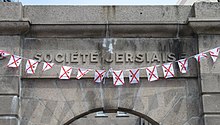Société Jersiaise
 |
|
| Formation | 1873 |
|---|---|
| Type | Learned society |
| Purpose | History, Archaeology, Natural History, Jèrriais |
| Location | |
|
Membership
|
2,000 (approx.) |
|
Activities
|
Research & Publications, Lectures & Events, Heritage Conservation, Exhibitions, Museum Collection |
|
Collections
|
Research Library, Paintings, Artefacts, Photographic Archive, Museum Collection |
|
President
|
C. W. Perchard, CVO, OBE |
| Website | www.societe-jersiaise.org |
The Société Jersiaise is a learned society in Jersey which was founded in 1873, in the manner of similar county societies in the United Kingdom and in France for the purposes of:
The Société continues to fulfill these objectives, with two important differences - because it can no longer be said that French is the official language, the encouragement of its use has been dropped and, secondly, an important addition to the aims is the study of all branches of the natural history of the island and publication of the results of fieldwork in these subjects. By 1878 a museum had been formed. In 1893 the Société moved to No. 9 Pier Rd, which continues to house the museum. The Société is a registered charity funded through subscriptions, donations and legacies.
On 28 January 1873 a meeting of notables of the island took place to discuss the formation of a society for the preservation of the island's archaeological, historical and linguistic heritage, perceived to be threatened by the expansion of St Helier and coastal development. Those present were aware of the foundation of similar societies in mainland Normandy, such as (founded 1824) and similar county societies in the United Kingdom. In 1893 the Société was given a large townhouse in Saint Helier which became the base for its operations including its library and museum. In 1913 the various branches of activity were formalised into 'sections', amongst the first being Archaeology and History. The Section structure still exists and now comprise some 15 sections.
From its inception the Société engaged in archaeological work at numerous sites around the island; most importantly beginning work at La Cotte de St Brelade in 1905, a Neanderthal site of international importance. In 1919 the Société purchased the important Neolithic site of La Hougue Bie, excavating it in 1924 revealing a Neolithic chambered passage grave c.4000BC. The site was then restored and opened as a museum. The Sociéte flourished throughout the 20th century, notwithstanding the difficult years of the German military occupation of the Channel Islands between 1940-1945. Despite the severe hardships and lack of resources suffered by the island, the museum at Pier Rd remained open throughout the Occupation, but despite protestations La Hougue Bie museum was requisitioned for military purposes by the Nazi occupiers.
...
Wikipedia
